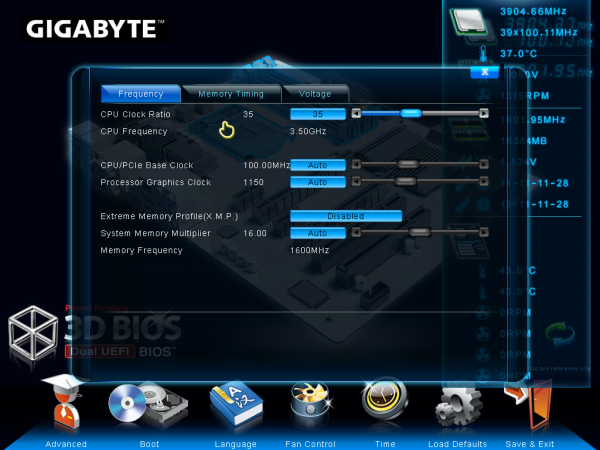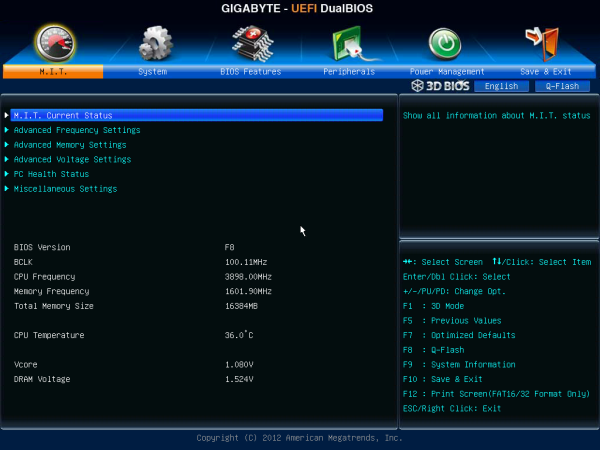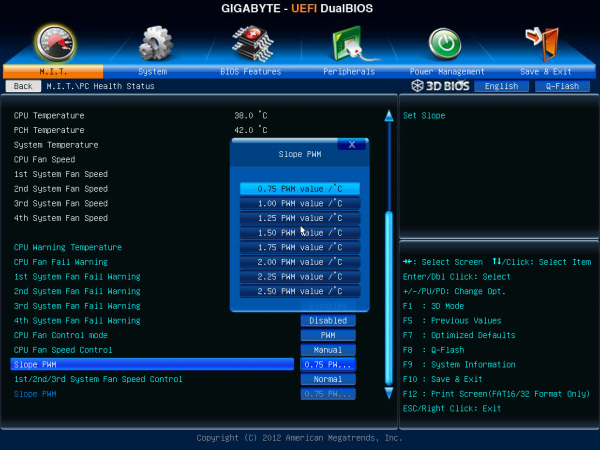Gigabyte GA-Z77X-UD5H Review: Functionality meets Competitive Pricing
by Ian Cutress on July 25, 2012 5:00 AM EST- Posted in
- Motherboards
- Gigabyte
- Z77
Gigabyte GA-Z77X-UD5H BIOS
As of late, I have been critical of the Gigabyte BIOS system. Their 3D BIOS implementation of a graphical UEFI used to be very slow to respond, and as a result made it a pig to navigate. Fast forward on a generation and our 3D BIOS is super fast, highly responsive, and more of a pleasure to use. The 3D BIOS philosophy is a little odd, as the only thing 3D about the BIOS screen is the perspective - it is still a 2D image but at an oblique angle.
The front screen of the Gigabyte BIOS uses this oblique image to act as a clickable interface for different parts of the motherboard. Users can select the CPU, the memory, the rear IO, the PCIe, the SATA connectors or the chipset in order to bring up a separate menu containing several advanced options for that area of the motherboard. This unfortunately falls down on a few areas:
Should a non-enthusiast user have this system as part of a pre-built computer (for example, my parents) and need to enter the BIOS, they will not know what to click as they do not understand what a motherboard is. I would not be able to explain 'click the SATA ports' as they do not know what SATA ports are. What we could do with here is some hover text over each part to explain what each part is in non-technical language.
In addition, as an enthusiast, my main priority of a BIOS is to manipulate and diagnose. The first screen I should see should have all the important information on it - the motherboard I am using, the CPU installed, the speed of the CPU (voltages and temperatures would be handy), the memory size, the memory speed, and other relevant data (boot sequence, hard drives). With a screen like 3D BIOS, some of this information is available straight away, and some is provided when the oblique image is clicked (see image below) but is covered by the menu brought up. For the real information, I will need to navigate through separate menus. There is enough leeway with a UEFI to be able to cater to both the enthusiast and the non-technical; it is just a shame that motherboard manufacturers still cannot get it right.
In the advanced menu, the first screen we come to is the M.I.T (Motherboard Intelligent Tweaker?). This has some valid information to greet us - BIOS version, CPU speed and voltage, memory size, frequency and voltage, and CPU temperature. The 'Current Status' option provides a longer list of exact settings, helpful for diagnosis.
Overclock options are found throughout several menus: CPU clocks and ratios are adjusted in "Advanced Frequency Settings"; memory timings and straps can be changed in "Advanced Memory Settings"; and anything relating to voltages or the 3D Power delivery options are found in "Voltage Settings". It does confuse me a little, as motherboard manufacturers have this overwhelming tendency to put options in one place only. The BIOS should be a tool that is easy to use, so why not put the voltage options for the CPU in with the CPU clocks and ratios? Or 3D Power options related to a CPU in a sub-menu in the Frequency options? The only motherboard manufacturer who is not using what is essentially a basic text and option interface right now is Intel on their own motherboards, so it does strike me as strange that no-one else is doing it.
Fan options in the BIOS are found in the M.I.T. -> PC Health Status menu, located at the bottom. Gigabyte fan controls are limited at best, especially when you compare them to the best in the motherboard arena - users here have to try to understand the options provided. The units PWM value / ºC mean nothing to everyone. Some sort of system needs to be devised here which users can input temperatures when they want the fans to idle and when they want the fans to be at 100%, and the BIOS calculates the appropriate 'PWM value/ºC' to select.
Despite my critical analysis of the Gigabyte BIOS, I found it easy to navigate by the arrow keys (my preferred method) and type in values during overclocking. It is a big step up from the first iterations of Gigabyte's 3D BIOS for sure.




















70 Comments
View All Comments
IanCutress - Tuesday, July 31, 2012 - link
Please note that even if you have purchased a '6Gbit/s' SSD, it will never run at that speed. If you look at our SATA and USB testing, none of the peak speeds we see in our benchmarking ever reach the peak advertised by the port due to the limitations of the hardware. They more often than not do not even reach the peaks of the hardware due to latency or real-world situations. Most rated speeds are for compressible continuous data with a high queue-depth - not ever a realistic scenario.Testing every 3rd party controller adds testing time. Going from 2-3 boards a month do maybe one and a bit. Especially if they're all connected differently on the board (which we don't always know without specific chipset diagrams for the specific product, which are not always available). After all, peak tests are limited in their understanding anyway - take the new USB boost technologies from ASUS and ASRock. ASUS' implementation affects mainly short size block transfers by several order of magnitudes (as found out in our testing), rather than peak by any significant amount.
I am quite astounded by your insistence that if you have many ports that they must all run at their peak speed in conjunction with each other at the same time. It just doesn't work that way. Have a gander at the chipset diagrams in our first Z77 reviews to understand this. Bandwidth is delivered to what needs it at the right time - the usage model for hammering all the ports at once is almost non-existent.
Ideally we'd love to test everything at the peak, but we do not have an unlimited amount of cash to go and buy equipment. We're independent freelance reviewers making do with what kit we can get together or are offered.
iCrunch - Sunday, July 29, 2012 - link
I've become so spoiled by how incredibly seamlessly, fast, and consistent Thunderbolt works. Add to that the fact that I can probably get most of the specs in an external Thunderbolt enclosure/dock solution fairly soon...albeit for a tad more money.Scootiep7 - Sunday, July 29, 2012 - link
Wow, so Gigabyte finally took my complaints to heart and started releasing boards with something other than that ALC887 miserable excuse for an audio codec. Bravo good sirs, better late than never. Now get it done on more of your boards!Questor - Tuesday, July 31, 2012 - link
I have this motherboard with an Ivy Bridge i5 3570K, currently at a stock speed, with a Plextor 128 GB SATA III SSD as the OS drive. Even with the post logo screen enabled, I get to desktop log-in in about 7 seconds. Excluding the "artificially" added time to type my password, full desktop is an average of 2.5 seconds from there. Not bad considering the programs I have that load versus Anantech testing.I have had my board since its early retail release and this has not changed much; even after replacing the original i5 2500K and Samsung SATA II 128 GB SSD for the above mentioned components.
Questor - Tuesday, July 31, 2012 - link
In addition to the boot time being misleading commentary and the response to the USB vs PS/2 keyboard, my present computer build with this Gigabyte board is one of the best/favorite rigs in my 14 years of building and tweaking computers.The other few are ASUS P8P67-PRO, Gigabyte MA790GP-UD4H (X2 with two cores unlocked to quad and STILL running stable), EPoX EP-9NPA+ Ultra, ASUS P5A with AMD K6-350 (severe electrical spike took it out after years of OCing - jumped the surge protector)!
Questor - Tuesday, July 31, 2012 - link
In addition to the boot time being misleading commentary and the response to the USB vs PS/2 keyboard, my present computer build with this Gigabyte board is one of the best/favorite rigs in my 14 years of building and tweaking computers. The other few are ASUS P8P67-PRO, Gigabyte MA790GP-UD4H (X2 with two cores unlocked to quad and STILL running stable), EPoX EP-9NPA+ Ultra, ASUS P5A with AMD K6-350 (severe electrical spike took it out after years of OCing - jumped the surge protector)!minlian - Sunday, August 12, 2012 - link
Is the reaction time DPC Latency error fixed on the Gigabyte Z77X-UD5H-WB-WiFi version or are they just the same motherboard with just a wifi difference?Triniman - Sunday, August 12, 2012 - link
Ian Cutress wrote, "...a total of 10 USB 3.0 ports available (if you have enough USB 3.0 panels)."Does anyone know of any cases that will would allow you to use the 3 onboard USB 3.0 headers?
Also, is it correct that the Gigabyte doesn't include drivers for these VIA controllers?
ETruett - Tuesday, September 11, 2012 - link
Hay. I am wondering if the Gigabyte GA-Z77X-UD5H Motherboard will fit in the Dell E510 Case? Or which Case can i get? I would like to build a nice gaming pc that whill not break me. I dont have much money. My eMail is: etruett9@gmail.com..... :-))gkatsanos - Monday, November 26, 2012 - link
Hi, It's weird how in any of the reviews there was a word for the problems (bugs) this M/B has. I ordered it a week ago and even if I upgraded my BIOS to the latest version, it still suffers from problems.. I had for example to disable the Marvell sata controller and connect my drive to the intel chipset one for the system to shutdown properly... Other folks have had freezes etc. Google the model + problems and you'll see. I am thinking of changing it with an Intel m/b or something more stable..